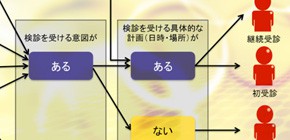
Success in increasing the rate of screening for breast cancer. Method grounded in behavior modification theory increased rate by a factor of 3!
A group of researchers -- HIRAI Kei , Visiting Instructor (Endowed Chair, Development of Complementary and Alternative Medicine, Graduate School of Medicine) and Associate Professor (Osaka University Academic Initiatives, Support Office for Large-Scale Education and Research Projects), SAITO Hiroshi , Manager, National Cancer Center, SHIBUYA Daisuke , Director, Miyagi Cancer Society, and ISHIKAWA Yoshiki , Researcher, Jichi Medical University (all had been former members of the Health, Labour, and Welfare Ministry through 2010)-- designed a successful method for encouraging women to undergo mammography screening. Based on the behavior modification theory, this method made use of three types of tailor-made print statements designed to increase the breast cancer screening rate.
The researchers confirmed the effectiveness of this method by conducting randomized controlled study in health checks sponsored by local municipal governments. The method for encouraging screening was referred to as "tailored message intervention." In this method, three types of tailored print messages were prepared. Next, based on characteristics from municipal records women were assigned to one of three groups (A, B, or C) or to a control group. A, B, and C refer to those judged of high intention to undergo screening (A), those judged as higher risk for cancer but with low intention (B), and those judged as low risk and low intention (C). One type of message was sent to the A group, another to B, and another to C. In comparison with the control group which received a non-tailored standard print message, the breast cancer screening rate turned out to be about three times higher among the women who received the tailored print messages, clearly showing it as more effective means for getting women to undergo screening.
This group's achievement compiles the results of three academic research projects published on Psycho-Oncology , Journal of Health Communication , and BMC Public Health noted below.

Figure 1

Figure 2
For more details on this research, please read the full research report noted at either of the websites noted below:
• " Worry and Intention Among Japanese Women: Implications for an Audience Segmentation Strategy to Promote Mammography Adoption ," Harada K, Hirai K, Arai H, et al. Health Communication, Jan 2013.
• " Cost-effectiveness of a tailored intervention designed to increase breast cancer screening among a non-adherent population : a randomized controlled trial ," Ishikawa Y, Hirai K, Saito H, et al., BMC Public Health, Sep. 11, 2012 2012;12.
Related links :
